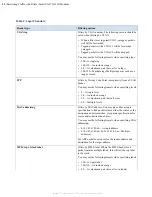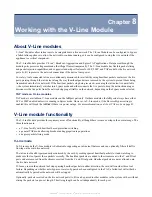
SmartNA-X 1G/10G Modular | Working with the V-Line Module |
63
SmartNA-X
™
1G/10G User Guide 1.4
©
2015 Network Critical Solutions Limited
Aggregation mode
V-Line Module Aggregation mode allows traffic from the live ports (A, B) to be copied and aggregated to tool ports (C,
D) in the same module or in a different mode, as shown in the following figures.
Figure 54: V-Line Aggregation mapping for A+B → C
Filters are not supported on maps from the V-Line module to other modules in the system.
Figure 55: Port Aggregation and cross-modular mapping
Aggregation mode also supports packet slicing (16–9216 bytes), allowing packet headers to be separated from the payload
to reduce the load on the network tools, and packet injection of low bandwidth data into the live network, as shown in the
following figure.
Figure 56: Port mapping for packet injection
When operating in Aggregation mode the
AB
port pair always operate as a TAP, with failsafe enabled. If required, you
can override this to disable the failsafe behaviour for that port pair by activating Reverse Bypass. For more information
about failsafe, see
on page 43.
Egress mode
The Egress mode allows traffic to be mapped onto the V-Line module from other ports on the system (via the internal
backplane) and taken out of the front ports, optionally slicing it first.
All four ports (A, B, C and D) work the same way in this mode, although the slicing configuration can be adjusted
individually for each port. Note that there is no traffic coming onto the V-Line card from the front ports at all in Egress
mode, so mapping from the front ports is not permitted.
Multiple system ports can be mapped (aggregated) to any one Egress port, but traffic filtering on the maps should be used
to ensure that the overall limit of 1Gbps of traffic per egress port is not exceeded.
Note:
The slicing facility is useful for reducing the number of bits that are to be sent to a network tool for
processing and/or storing. However, slicing is
not
intended as a replacement for the correct application of filters in
reducing aggregated traffic to prevent overloading a port.
















































